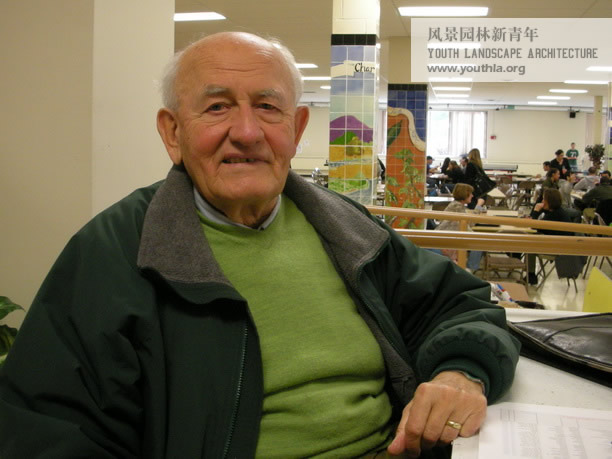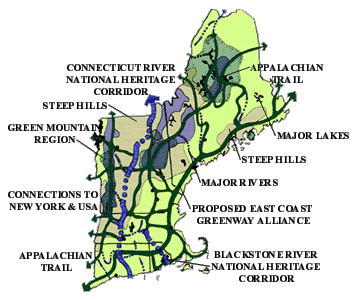笔者按:与Fábos教授的第一次会面是在系馆的办公室,我如何都不能将他壮硕的体格和炯炯有神的目光与近80岁的高龄挂钩。虽然已经退休,Fábos教授还是在每周四参加系里惯例的教员会议,而且不断的努力推进绿道(Greenway)的推广,11月中寻他就将飞往他的故乡匈牙利,去准备明年在那里举办的绿道规划国际会议(Fábos Conference on Landscape and Greenway Planning)。虽然这次谈话只有十几分钟,但他的乐观、开朗和可爱的固执都给我留下了深刻的印象,我们相约几日后再见,于是便有了这篇访谈。
朱利叶斯·法布士(Julius Fábos),国际著名的风景园林师、教育家,现为美国马萨诸塞大学风景园林与区域规划系(University of Massachusetts Amherst, Department of Landscape Architecture and Regional Planning)荣誉教授,美国风景园林师协会(ASLA)常务理事,美国风景园林协会1997年金质奖章获得者(ASLA Medal),美国国家级风景园林大师,亦是著名的“绿道”(Greenway)的倡导者,美国“绿道”论坛主任。

采访对象:Julius Gy. Fábos(以下简称Fábos)
采访者:周啸(以下简称周)
采访时间:2009-11-5
周:跟据相关材料,绿道中的“绿”(green)来自绿带(green belt1),而“道”(way)来自公园道(parkway2),请问绿道与两者的关系?
Fábos: “绿”并不完全是从绿带而来,两者之间有比较显著的差别。绿带是一种更加人工化的概念,它是指城市中呈带状相连的需要保护的绿色开放空间。而绿道则是更加自然的过程,而非人工化的概念。绝大多数绿道经过诸如绿色区域、河流和溪流等水体自然流经的地段。它从土地延伸至河流,最后到达海洋。绿道通常包括一个你不能进入的自然的廊道,一旦闯入你可能受伤、可能浑身湿透。绿道包括至少三种用途,一是游憩;另一个是自然保护,保护自然的廊道使野生动物可以通过;第三种是文化保护,因为沿河会有很多历史的和文化的活动出现,它们是具有保护价值的。这些就是绿道主要的功能。公园道的概念始于90年代,它是一种连接城市区域的系统。有的公园道可以成为绿道,但其大多数是交通系统,所以公园道比绿道更加人工化,更接近绿带。

周:请讲讲您为何会开创绿道?
Fábos: 我并没有创造出绿道,我加入了创立它的组织。绿道的概念不是由我首创,下面讲讲其历史。我是一个风景园林规划师和设计师,但我首先是规划师。风景园林规划与风景园林设计不同,规划是一个让土地能够合理使用的过程。过去我们想要推广风景园林规划的时候,我们发现这很难,因为绝大多数人并不了解它。绿道规划在当时是一项社会活动,我加入了这项活动并进行风景园林规划,当时是1985年。后来为了配合这项活动,都市区域风景研究小组(MENTLAND)成立了,我便加入了它。
现在世界各地有很多绿道规划的项目,而且我们每三年都举办一次绿道规划国际会议(Fábos Conference on Landscape and Greenway Planning3)。在美国,绿道已经成为一件颇有影响力并能带来机遇的事物。“从铁路到散步道管理局(rails to trails conservancy4)”就是一个好例子,它在美国很有影响力。美国有许多铁路,大多数都已经被遗弃了,当太多铁路被遗弃的时候,重新利用它们就成为一种需求。这时铁路可以转化为散步道。美国目前有大约二十五万英里(约合四十万千米)的废弃铁路,其中许多正在转变为绿道. “从铁路到散步道管理局”是一个推进此项运动的机构,在过去的10年间,它每年都使上千英里的铁路转化为绿道。要知道我们还有数不清的河流和溪流,可能还有数百万英里的自然廊道,所以绿道还有很巨大的发展空间。
周:中国的风景园林设计师更多的关注设计,而非规划,在您看来规划和设计有怎样的联系呢?
Fábos: 风景园林规划在整个过程的最开始非常重要,所有事情都始于规划,它是一个过程,这个过程告诉你做什么、在哪做以及为什么这样做,而设计是展现如何做。假如你在一个不合适的地点进行设计,那你不可能成功。就好比找女朋友,她应该是个客气的、能一起过日子的人,不然你们最终只有离婚。所以说选择合理的土地利用方式是最重要的,我之所以选择做一名规划师是因为我希望能做最合适的事情。设计在规划之后,假如你第一步的选择是对的,那么其他事就好办了。你不可能先设计再规划,设计是一种创造形状的魔法,我总是将设计师说成是形式设计师。设计什么形式并不重要,圆形也好、十字形也好、其他也好,能怎样呢?这个设计在此合适吗?如果你做了错误的决策,什么设计都不管用,所以规划更加重要,不是设计。
周:中国目前面临城市环境差、绿色开放空间少、河流严重污染等问题,在这种情况下如何开展绿道规划呢?
Fábos: 在美国,我们开始于清理河流。
不知你是否了解约翰逊(Johnson)总统吗,肯尼迪(Kennedy)总统遇刺后便是约翰逊总统,他可能是推进绿道运动最重要的政治家。他声明希望在自己有生之年能在波特米克河(Potomic River)游泳。为什么呢?波特米克河在当时污染十分严重,以至于人们不能在其中游泳。他这样说的意思就是要指出,我们必须清理这条河流。这是一个很重要的关于环境的决策和目标,尽管这个目标从未完全实现,但它指明了方向。约翰逊总统对于我们是一位很重要的政治家,他的妻子也是环保主义者。这就是你们需要做的幕后工作,政治家是政策决定者,风景园林设计师和规划师不是,只有合适的决策定下来你们才能走下去,这就是为什么你们要加入权力圈子,没有他们,你们什么都不能做。
就像我之前提到的,绿道不同于绿带,河流对于绿道更加重要,有河流就有湿地,湿地沿河而生,它们不适于建设,但它们却是绿道发展的机遇。对于绿色开放空间,如果你能像绿道规划理论建议的那样尊重自然法则,绿道自然会提供给你。这很简单,如果土地不适于建设,就将它保留为绿地。
周:请介绍一些您重要的作品。
Fábos: 我人生中第一个规划项目是为马萨诸塞州(Massachusetts)的楠塔基特岛(Nantucket Island)进行全岛的规划。岛上大约四分之三的土地都被永久的保护起来,不能进行建设。那是一个成功的项目。
第二个项目是北大西洋区域研究(North Atlantic Regional Study)。它包含了美国13个州,6个来自新英格兰地区,7个为其他地区。它从缅因州(Maine)开始经过波士顿(Boston)到达鳕鱼角(Cape Cod)。有21条主要的河流经过这个区域流入太平洋,我们将每一条都进行了研究。这是我所做过的最大的项目,我们花了很多年在这上面,现在还在研究。从这个项目开始风景园林师在规划方面有了重要的影响。现在你应该能看出风景园林规划与设计在尺度上的不同,设计关注小事物,而大的方面则是规划来管,也就是我研究的方向。
目前我在为即将在匈牙利举办的国际绿道规划会议写演讲稿。欢迎你们参加。
注:
1.绿带(green belt):指临近城区的未发展区域,通常由规划法律保护而不能进行开发建设。(来自维基百科)
2.公园道(parkway): 指大街或通道之间和两边的一系列风景化的土地。(来自维基百科)
3.会议网站:http://fabos.uni-corvinus.hu/
4.rails to trails conservancy官方网站:http://www.railstotrails.org/aboutUs/index.html
Interview with Professor Julius Gy. Fábos
Prof. Julius Fábos is an internationally well-known landscape architect and educator, he is an honorary professor at the Department of Landscape Architecture and Regional Planning, University of Massachusetts Amherst. Prof. Julius Fábos is the author and editor of more than 120 articles and research bulletins, as well as five books. Through this interview, Mr. Fábos inspired me with his optimism, vision and humor.
ZX=ZHOU Xiao
Fábos=Julius Gy. Fábos
ZX: The term greenway comes from the “green” in green belt and the “way” in parkway, what is the relationship between your greenway and the other two?
Fábos: The “green” is not exactly from green belt. There is a major difference between greenway and green belt. Green belt is a more artificial idea. It means if you have a city, you should have some green spaces along the belt for protection. The greenway is a more natural process. It is made by nature not by artificial methods. The major greenways are along green areas, along rivers and streams where the water naturally moves. It moves from the land to the river and to the ocean. The greenways usually have a corridor where you should not be there because it’s a natural area. If you get there, you get wet, or get hurt. Also, the greenway contains at least three kinds of uses. One is recreation. Another is nature protection, to protect the corridors where wild life moves along. The third is culture benefits, because along the rivers there are a lot of historical and cultural activities, they are worth to be protected. These are the three major aspects.
Parkway idea started in the 19th century as a green system to connect cities and urban areas. Parkways can be greenway but most of them are not. Most of them are transportation roads, so parkways are more artificial than greenways. It is more similar to green belt than greenway.
ZX: When and why did you get the idea of greenway planning? What’s your inspiration?
Fábos: I didn’t get the idea, I joined the group. The idea didn’t come from me. Let me tell you the history of it. I am a landscape planner first and I am a landscape architect and landscape planner. Landscape planning is defined from landscape design. It is a planning process which access land for appropriate uses. When we wanted to sell landscape plan, it was very difficult because most people don’t know about it. Greenway was a movement at that time, I joined that movement and did landscape planning and greenway. It was in 1985. Since they establish a group (METLAND) to corporate the movement, I joined them.
There are a lot projects located internationally nowadays and we have greenway conference every three years. In America, greenway has become a big issue as well as a big opportunity. The rails to trails conservancy is a good example, it is a big issue in America now. There are a lot of railroads in America, most of them are abandoned. The rails can become trails. When there are too many abandoned rails, new use of them are needed. I’ve a number for you, in American, there are about 250,000 miles have been abandoned and many of them are being turning into greenways. The rails to trails conservancy advocate it. In the last 10 years, they did as much as thousands of miles per year. The opportunities are fantastic, if you see how many rivers and streams we have. There are probably millions of miles of these natural corridors so we have huge opportunities.
ZX: Landscape Architects in China focus more on Landscape Design. People know much less about landscape planning, what is your opinion about the relationship between planning and design?
Fábos: Landscape planning is more important at the beginning. Everything starts at planning, it is a process that defines what to do, where and why and how design is to show. If you design in an inappropriate place, then you will not be successful. At first, you have to decide to do the right thing. Just like when you look for a woman, you want her to be a complimentary person who can live with you, otherwise you will divorce. So the site selection is the most important thing, selecting the appropriate use. The landscape planning is to do that. I chose to be a planner because I want to do the most appropriate things. Design is after panning, if your first decision is right, the others will be simple. Both of planning and design are important, however, you cannot design first and plan last. Design is a magic, to create forms and shapes. I often refer designers as shape designers. The meanings of design are more basic before what is the proper use of the land, that is a more important decision. What shape has been done makes no difference, circles are good, crosses are good, others are good, so what? Is the design appropriate or not? If you make a wrong decision, they will not work. So planning is a more important decision, not design.
ZX: Poor urban environment, low rate of urban green spaces and heavy river pollution are some of the serious problems in China. Under such conditions, do you have some suggestions about how to start the greenway planning?
Fábos: In America, they started virtually by cleaning the rivers. Have you heard about President Johnson ? After President Kennedy was killed, the next President was Johnson. He was probably the most important politician helping the greenway movement. He declared that in his life time he would like to swim in the Potomic River. Why? The river was so polluted that you couldn’t swim in it. By saying “In my life time, I want to swim in the Potomic River”, he meant we had to clean up the river. This was a major environment decision, an aim and a goal. This could never be fully achieved but it was a direction. He was a very important politician for us and his wife was also an environmentalist. These are some of the background what you have to do. Politicians are decision makers, landscape architects and planners are not decision makers. You can do only if the proper decision is made. That’s why you have to join forces with the power beings. Without them, you cannot do.
As I said, instead of greenbelt, the rivers are more important in greenway system. If you have a river, there are also wet lands. Wet lands are along rivers, those are bad for development while they are opportunities for greenways. For the green open spaces, if you respect the nature, as the greenway planning suggest, then they are given to you. It’s very simple, if the lands are not appropriate for development, keep it green.
ZX: Can you please introduce some of your important works?
Fábos: My first landscape planning work in my life is for the whole island of Nantucket in Massachusetts. About three forth of the island has been permanently protected from development. It was a big success.
The second work is the North Atlantic Regional Study. It contains 13 states, 6 states in New England and 7 from others. It is the whole north east coast that starts from Maine to Boston, then Cape Cod. There are 21 major rivers coming down to the ocean, we have studied each of them. That was the biggest work I have ever done. We worked for years on this project. This was where landscape architects had a major influence on planning. And we are still doing it. You can see the difference in scale between planning and design, design focus on minor issues like what shape I would give, where the sitting area is. The major issues are planning issues. That’s my direction.
I’m just writing a presentation form the greenway conference in Hungray for several weeks. Welcome to join the conference.

文化生态与感知
先占个地。。。。坐沙发上漫漫看
看完了。。。学到了不少~~
“绿脉通常包括一个你不能进入的自然的廊道,一旦闯入你可能受伤、可能浑身湿透”___这句话很重要。
你不知道现在国内“绿道”有多热,随便两行行道树也能扯上绿道的大旗。
我总觉得,中国的设计师和理论家们总是过多地沉浸于新鲜的“概念”,而往往对概念背后的真实含义不求甚解。
怪不得古代有买椟还珠的寓言故事呢。
@王欣, 这也是没办法的事,国内的设计市场化太严重了,只要能有广告效应,都可以拿来用。绿脉的知识我也是一知半解,争取这2年能学的多一点。
@周啸,
好好学,多介绍。最近广东省开始做“绿道规划”呢。
还找了一大批人做了一个研讨。新闻有报道。
你能否根据这个报道并且在网站上评论下?
@王欣, 对不起,仅凭新闻报道我不敢妄下评论,而且我自己对绿道也了解不多。
@周啸, 我感觉身在西方反观这样一种现象的话比较有意思,这个问题就联系到了 Theory-globalization,就是西方一直向全球输出各种理论,而这很多理论都是植根于欧洲或者北美的社会发展和他们的历史,与其它国家自身的文化及历史没有啥关系。而很长时间以来这样一种戏剧性的,甚至是突破时空的拼贴出现了很多问题,也达到了好多意想不到的效果。 不过以现在的这种信息的传播速度和资本流动方式,我同意他们好多关于全球化的学者的观点, 以后的趋势不会再是中国,美国,日本之类的了, 而是北京,纽约,大版,迪拜了
@YanMing, 同意,我们不能崇洋媚外。
有21条主要的河流经过这个区域流入“太平洋”应为大西洋
@yzyw, 呵呵,搞错啦,谢谢!
@周啸, 不客气,就是对地理敏感点=)
支持呀。。很可惜Julie不开studio了。。umass的一大损失。。
“The greenway is a more natural process. It is made by nature not by artificial methods.”
If we do something to create a greenway, that must not be the greenway~
Greenway没有一个绝对的定义,Fabos的定义也是停留在他对Greenway的理解上,所以不要将此奉为真理。
其实我们在做珠三角绿道的时候也研究过究竟什么是greenway,怎么看待greenway的问题,可某个boss提出要一年全线拉通,两年基本建成,三年成熟完善~~~中国特色啊~
这个政策听起来就像建造某种建筑,但绿道不光是建造,更是保护和限制,在大尺度上是强调生态和历史保护的,而不是强调休憩。
Good job! Xiao.
Thanks.
现在绿道在中国很热,什么时候能有个标准,不要“把简单的行道树再成为绿道”那,如何能把中国的绿道搞好那?